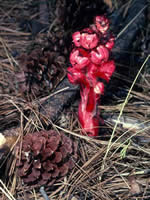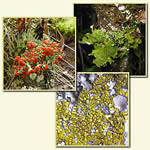USDA Forest Service Celebrating Wildflowers
|
|
|
Interesting (and often overlooked) Plants on Our National Forests and Grasslands"I believe a blade of grass is no less than the journey-work of the stars" ~Walt Whitman Interesting Plants on Our National Forests and Grasslands takes a closer look at a myriad of unique, often unusual, often over-looked, and always fascinating groups of plants. From the Chugach National Forest in Alaska to the El Yunque National Forest in Puerto Rico, and areas in between, we will explore bryophytes (mosses, liverworts, and hornworts), lycopods, ferns, lichens, grasses, aquatic plants, and many other interesting groups from the plant world. Explore these pages and learn of the wonders of the world of cryptic, over-looked, and unassuming plants on our national forests and grasslands! Thieves from the Heath - Mycotrophic WildflowersSometimes referred to as "fungus flowers," mycotrophic wildflowers have no chlorophyll and spend most of their lives underground, but are not fungi. Since they cannot make their own "food," the mysterious mycotrophic wildflowers "tap" into and parasitize mycorhizal fungus, which absorbs its nutrients from trees. The unlucky fungus "feeds" the parasitic wildflower and receives nothing in return. They come in a variety of colors, reds, yellows, white, pinks, and browns; and, are most often found under thick layers of leaf litter in deep-shaded forest floors. This Interesting Plants feature explores the world of mycotrophic wildflowers of the heath family (Ericaceae). LichensLet's take a look at the group of organisms called lichens. Truly, they are not plants in the scientific division of life forms, but rather they belong to the Fungi kingdom. In the past and even today, Forest Service botanists and plant ecologists are the primary resource specialists who deal with the conservation and management of these beautiful and fascinating organisms. |
|
| NOTE: PDF format links require the Adobe Acrobat Reader to view. | |
| top | Disclaimers | FOIA | Privacy Policy | Quality of Information | Photo Credits & Use |
Location: http://www.fs.fed.us/wildflowers/interesting/index.shtml
Last modified: Monday, 02-Mar-2009 16:32:04 EST

